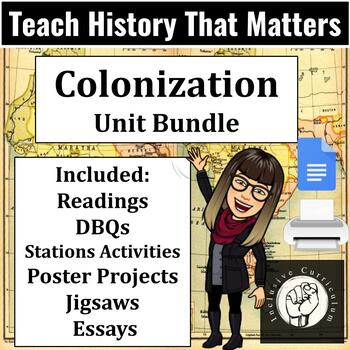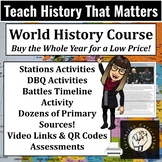Colonization Group Activities, Primary Sources, DBQs, Assessment, Unit Bundle
- Google Docs™

Products in this Bundle (5)
Also included in
- World History Year Long Course Bundle- Everything you Need! DBQs & ActivitiesThis is an inclusive world history!Print & Go! Or edit as you see fit!Do you teach World History or AP World History? These activities, DBQs, and assessments cover all the CA World History standards for Grade 10 inPrice $101.89Original Price $155.77Save $53.88
Description
5 Activities Included! Everything done for you! Easily over a month worth of material.
Colonization of Africa, DBQ Stations & Map Activity Includes: What caused the "Scramble for Africa"? By ThoughtCo.com (modified) Station 1: Map of Ethnic and Linguistic Groups in Africa Station 2: Map of Ethnic and Linguistic Groups Divided Station 3: Map of African Resistance Station 4: West Africa Station 5: North Africa Station 6: East Africa Station 7: Southern and Central Africa Station 8: Africa Before Colonialism Through Art Station 9: African Voices Station 10: European & American Voices How did Colonization Work? DBQ Activity Case Study on King Leopold in the Congo Sources Included: Source 1: An Investigation Into Congo Colonialism, 1890 By George Washington Williams Source 2: Heart of Darkness Joseph Conrad, Published: 1902 Source 3: DR Congo: Cursed by its natural wealth By Dan Snow with the BBC Source 4: King Leopold’s choking grip on the Congolese as shown in a 1906 Punch cartoon. Source 5: Origin of Source: King Leopold’s Ghost by Adam Hochschild (1998) Source 6: “Report from his majesty’s consul at Boma respecting the administration at the Independent State of the Congo” by Roger David Casement (1904) Are you looking for a student centered activity that will encourage your students to work together and utilize higher order thinking skills? Try jigsaw! - Student centered rather than teacher directed - Fosters inquiry learning - Increases enjoyment of the learning experience - Requires very little teacher preparation. Print & go! - Allows for larger coverage of curriculum material but the same student accountability of learning - Equity in access to learning - Encourages positive classroom culture by reducing racism and biases - Holds each student accountable! The Colonialism of Asia and Latin America Jigsaw Essential Questions: What was the impact of European colonization and American imperialism on the world? How do some groups resist control of others? Historical Context: In the late 1800s and early 1900s, imperialism affected many societies throughout the world. Perspectives on imperialism differed depending on a person’s point of view. Students will be broken up into 6 large groups (A-F) of 4. Assign each student a number 1-4 Group 1: The British Colonization of India Group 2: The Spanish Colonization of Latin America Group 3: The American Imperialism of Latin America & Asia Group 4: The American & British Imperialism of China Leaders of the Revolutions Research Poster Project Directions: Using articles provided and their own outside research groups must answer the following questions on your poster: Early Life Historical Background on Revolution(Who were they revolting from? Why?) History of Colonization (How were the people treated by the colonizers?) Revolutionary Ideas (What kind of new government/laws did this leader want?) Legacy Includes Cooperative Poster Jigsaw Groups:
The Father of Modern China Sun Yat-sen
José Martí Cuban Patriot
Menilek II Emperor of Ethiopia
Simón Bolívar Venezuelan Leader
Emiliano Zapata Mexican Leader
Toussaint L'Ouverture Haitian Leader
Che Guevara Marxist Leader
Mahatma Gandhi Nonviolent Leader of Indian Independence
Emilio Aguinaldo Filipino Leader of Independence
Standards:
Students analyze patterns of global change in the era of New Imperialism in at least two of the following regions or countries: Africa, Southeast Asia, China, India, Latin America, and the Philippines.
1. Describe the rise of industrial economies and their link to imperialism and colonialism (e.g., the role played by national security and strategic advantage; moral issues raised by the search for national hegemony, Social Darwinism, and the missionary impulse; material issues such as land, resources, and technology).
2. Discuss the locations of the colonial rule of such nations as England, France, Germany, Italy, Japan, the Netherlands, Russia, Spain, Portugal, and the United States.
3. Explain imperialism from the perspective of the colonizers and the colonized and the
varied immediate and long-term responses by the people under colonial rule.
4. Describe the independence struggles of the colonized regions of the world, including
the roles of leaders, such as Sun Yat-sen in China, and the roles of ideology and
religion.



